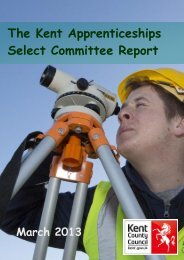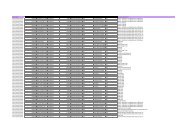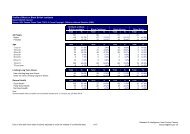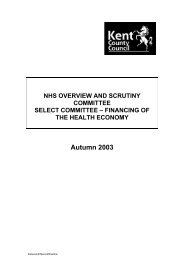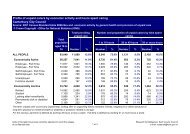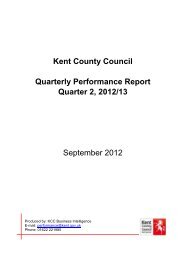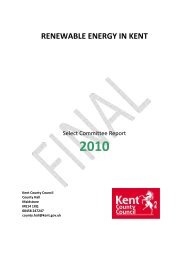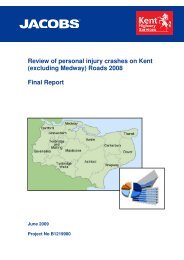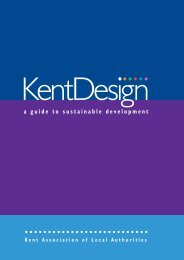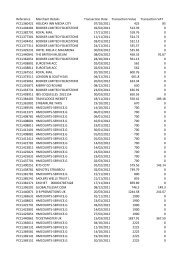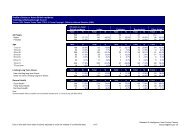Kent Design - Technical Appendix - Kent County Council
Kent Design - Technical Appendix - Kent County Council
Kent Design - Technical Appendix - Kent County Council
Create successful ePaper yourself
Turn your PDF publications into a flip-book with our unique Google optimized e-Paper software.
highways specification and construction<br />
Traffic Category shall be to BS 4987 Category B<br />
All material shall comply with Clause 901 and this Section<br />
Basecourses should wherever possible be laid in conjunction with<br />
roadbases and may be used by traffic. Any damage to the surface<br />
should be made good with basecourse or surfacing material.<br />
Dense Bitumen Macadam develops its strength largely as a<br />
consequence of good compaction whilst the material is adequately<br />
hot. The air voids in dense macadam and hot rolled asphalt shall be<br />
checked using a calibrated nuclear density meter at a rate of 1 test<br />
per 25 linear metres of carriageway.<br />
The mean total air voids in Dense Bitumen Macadam shall comply<br />
with the requirements of Clause 929 except that for routine<br />
purposes a calibrated nuclear density gauge may be used<br />
The mean total in-situ air voids of six consecutive determinations on<br />
Hot Rolled Asphalt shall not exceed 5%, with the air voids in any<br />
individual determination not exceeding 8%. The Air Voids content<br />
shall be calculated to ±0.1% as follows:<br />
Air Voids content = ( 1 - ρ/ρmax ) x 100%<br />
where ρ is the initial dry bulk density determined in accordance with<br />
BS 598 Part 104 and ρmax is the maximum density of the Hot Rolled<br />
Asphalt determined in accordance with BS DD 228:1996.<br />
Where there is uncertainty 150 mm diameter cores shall be taken at<br />
the same frequency as stated above and the Air Voids content<br />
determined. They shall comply with the requirements above.<br />
The satisfactory performance of thin surfacing depends upon a good<br />
bond between the surfacing material and the basecourse. Before the<br />
wearing course is laid all loose material or other material adhering to<br />
the surface shall be removed by mechanical broom and if necessary<br />
water jetting.<br />
The surface texture shall comply with the requirements of <strong>Kent</strong> <strong>County</strong><br />
<strong>Council</strong>`s Specification for Low texture, initially and retained for 2 years<br />
54<br />
<strong>Kent</strong><br />
<strong>Design</strong><br />
TABLE 17: ROLLED ASPHALT<br />
The surfacing provides the impermeable and skid resistant surface to<br />
the road, it is constantly visible to the public and defines their view of<br />
the quality of construction.<br />
3.4.8 CONSTRUCTION OF ROAD PAVEMENTS - BLOCK PAVED SURFACE<br />
In the case of Local Distributor Roads, Industrial Access Roads, Major<br />
Access Roads and Minor Access Roads block paving shall be laid in<br />
45 O herringbone pattern.<br />
Minor Access Ways and Home-zone block paving may be laid either<br />
in 45 O herringbone pattern or in stretcher bond at 90° to the kerb.<br />
There shall be two stretcher courses adjacent to kerbs and a single<br />
stretcher course round ironwork.<br />
Block paving shall be laid in accordance with BS 7533 Part 3. (Clay<br />
and Concrete pavers: Code of practice for construction of<br />
pavements).<br />
The structural strength of a road with a block paved surface depend<br />
upon the thickness of laying sand not exceeding the permitted<br />
tolerances. Any low areas in the roadbase must be made good with<br />
well rammed hot dense bitumen macadam prior to surfacing taking<br />
place. Significant areas outside the permitted tolerances will require<br />
the roadbase to be removed and reinstated to the correct tolerances.<br />
Block Paving shall have a minimum Polished Paver Value of 45<br />
3.4.9 JUNCTION WITH CONCRETE CARRIAGEWAY<br />
Where flexible construction meets a rigid concrete road, a double<br />
row of granite setts bedded on at least 150mm of ST2 mix concrete<br />
and jointed fully with strong cement mortar, shall be laid across the<br />
full width of the joint.<br />
The full depth of construction shall be maintained beneath the sett<br />
paving.<br />
Clause Material Thickness BS594 Coarse aggregate Binder PEN Remarks<br />
(mm) Table Col Nom % Size (mm)<br />
904 Roadbase 90, 80, 70 2 2/5 60 28 50 Up to 60% recycled asphalt may be<br />
905 Basecourse used in accordance with Clause 902<br />
905 Basecourse 60 2 2/4 60 20 50<br />
905 Basecourse 40 2 2/2 50 14 50<br />
TABLE 18: COATED MACADAM<br />
Clause Material Thickness Mix Coarse aggregate Binder PEN Remarks<br />
(mm) Size Min Max<br />
mm PSV AAV<br />
Notes:<br />
932 Roadbase/ 90, 80, 70 Clause 929 28 n/a n/a 50<br />
934 basecourse<br />
60, 50, 45 Clause 929 20 n/a n/a 50<br />
906 Basecourse 40 BS 4987 Clause 7.3 14 n/a n/a 100<br />
906 Basecourse 25 BS 4987 Clause 7.4 10 n/a n/a 100<br />
Clause 929 material shall have the<br />
approval of the Engineer following an<br />
on-site or off-site approval trial.<br />
Up to 60% recycled asphalt maybe<br />
used in roadbase or basecourse in<br />
accordance with Clause 902<br />
912 Wearing course 35 BS 4987 Clause 7.4 10 50 12 100 Traffic category B<br />
912 Wearing course 20, 15 BS 4987 Clause 7.5 6 45 12 100 Traffic category B<br />
a) Gravel aggregate is not permitted<br />
b) Where it is necessary to use the Hot Rolled Asphalt Basecourse as the<br />
running surface for traffic of any kind for more than 7days, the percentage of<br />
materials passing the 75micron BS sieve shall be not less than 5%<br />
c) The delivery temperature at any point in the load shall be in the range 165 o C to 120 o C<br />
(50Pen) 155 o C to 120 o C (100Pen)



